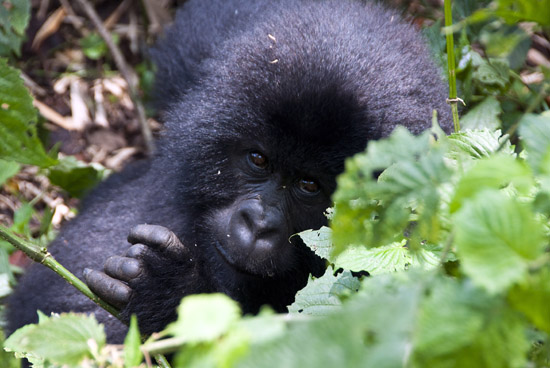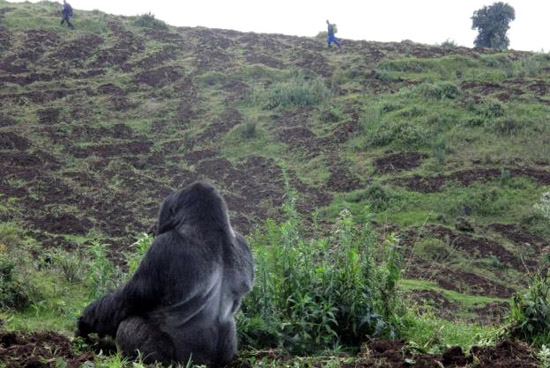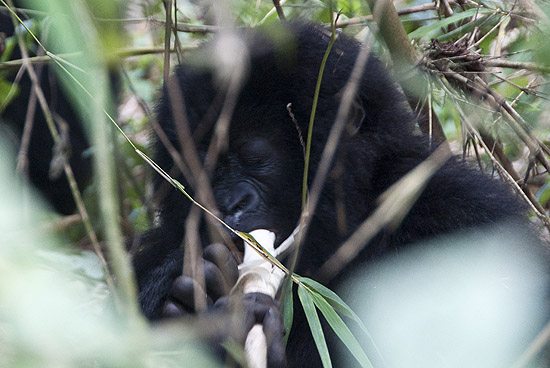Human Virus Linked to Deaths of Endangered Mountain Gorillas
By Gorilla Doctors Staff on Tuesday, March 29th, 2011 in Uncategorized.PRESS RELEASE
March 29, 2011
Human Virus Linked to Deaths of Endangered Mountain Gorillas
Musanze, Rwanda – For the first time, a virus that causes respiratory disease in humans has been linked to the deaths of wild mountain gorillas, says a team of researchers in a new study published online today in the CDC journal Emerging Infectious Diseases.
Their study, which reports the 2009 deaths of two mountain gorillas that were infected with a human virus, confirms that serious diseases can pass from people to these endangered animals.
The study authors include researchers from the nonprofit Mountain Gorilla Veterinary Project (MGVP); the Wildlife Health Center at the University of California, Davis; the Center for Infection and Immunity at Columbia University; and the Rwanda Development Board.
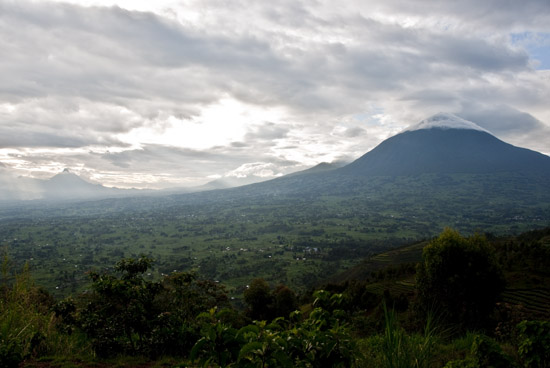
The sharp divide between gorilla habitat and farmland visible on the slopes of Mt. Muhabura in Rwanda.
“Because there are fewer than 800 living mountain gorillas, each individual is critically important to the survival of the species,” said Dr. Mike Cranfield, Executive Director of MGVP and a UC Davis Wildlife Veterinarian. “This discovery makes it clear that living in protected national parks is not a barrier to human disease.”
Humans and gorillas share approximately 98 percent of their DNA. This close genetic relatedness has led to concerns that gorillas may be susceptible to many of the infectious diseases that affect people.
The potential for disease transmission between humans and mountain gorillas (Gorilla beringei beringei) is of particular concern because over the past 100 years, mountain gorillas have come into increasing contact with humans. In fact, the national parks where the gorillas are protected in Rwanda, Uganda and the Democratic Republic of Congo are surrounded by the densest human populations in continental Africa.
Also, gorilla tourism–while helping the gorillas survive by funding the national parks that shelter them–brings thousands of people from local communities and around the world into contact with mountain gorillas annually.
The MGVP veterinarians, who monitor the health of the gorillas and treat individuals suffering from life-threatening trauma and disease, have observed an increase in the frequency and severity of respiratory disease outbreaks in the mountain gorilla population in recent years.
Infectious disease is the second most common cause of death in mountain gorillas (traumatic injury is the first). “The type of infection we see most frequently is respiratory, which can range from mild colds to severe pneumonia,” said co-author Dr. Linda Lowenstine, a UC Davis Veterinary Pathologist who has studied gorilla diseases for more than 25 years.
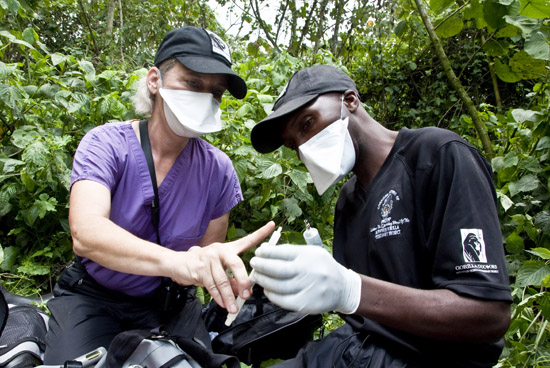
Gorilla Doctors Jan Ramer and Eddy Syaluha prepare an antibiotic dart for an infant gorilla sick with respiratory disease.
The two gorillas described in the new study were members of the Hirwa group living in Rwanda. In 2008 and 2009, this group experienced outbreaks of respiratory disease, presenting symptoms such as coughing, eye and nose discharge, and lethargy. In the 2009, Hirwa group consisted of 12 animals: one adult male, six adult females, three juveniles and two infants. All but one became ill and an adult female and a newborn infant died.
Tissue analyses showed the biochemical signature of an RNA virus called human metapneumovirus (HMPV) infecting both animals that died. While the adult female gorilla ultimately died as a result of a secondary bacterial pneumonia infection, the HMPV infection likely predisposed her to pneumonia. HMPV was also found in the infant gorilla, which was born to a female gorilla that showed symptoms of respiratory disease.
The study’s UC Davis authors are Drs. Cranfield, Lowenstine and Kirsten Gilardi, Co-Director of the UC Davis Wildlife Health Center’s Mountain Gorilla One Health Program. The lead author is Dr. Gustavo Palacios, a virologist at the Center for Infection and Immunity at Columbia University in New York. Other authors are from the Mountain Gorilla Veterinary Project, Columbia University and the Rwanda Development Board.
The research was supported by Google.org; the U.S. National Institutes of Health; the Emerging Pandemic Threats PREDICT program of the U.S. Agency for International Development; and a grant from the David and Lucile Packard Foundation.
Watch a video showing the Gorilla Doctors performing an intervention on Noel, a young male gorilla in Rugendo group in Virunga National Park, DRC. This January, the gorilla had been sick with respiratory disease for several days with symptoms worsening so MGVP veterinarians darted him with antibiotics. He made a quick recovery:
About Mountain Gorillas
With only about 786 individuals left in the world, mountain gorillas are a critically endangered species. Mountain gorillas live in central Africa, with about 480 animals living in the 173 sq mile Virunga Volcanoes Massif, which combines Volcanoes National Park in Rwanda, Virunga National Park in the Democratic Republic of Congo, and Mgahinga National Park in Uganda. The remaining population lives within the boundaries of the 128 sq mile Bwindi Impenetrable National Park in Uganda.
About the Mountain Gorilla Veterinary Project (MGVP)
MGVP, a U.S.-based nonprofit organization, is dedicated to saving mountain gorilla lives. With so few animals left in the world today we believe it is critical to ensure the health and well being of every individual possible. Our international team of veterinarians, the Gorilla Doctors, is the only group providing wild mountain gorillas with direct, hands-on care. MGVP partners with the UC Davis Wildlife Health Center to advance One Health strategies for mountain gorilla conservation. www.gorilladoctors.org.
About the UC Davis Wildlife Health Center
The UC Davis Wildlife Health Center, home of the Mountain Gorilla One Health Program, is a multidisciplinary program within the School of Veterinary Medicine at UC Davis that focuses on the health of free-ranging and captive terrestrial and aquatic wild animals. It is the umbrella organization under which faculty, staff, students, and other partners come together to address the complex issues surrounding conservation in a changing world. The Center draws upon faculty expertise spanning a wide range of wildlife species and scientific disciplines and attracts students from around the world to participate in its research and educational programs. In 2009 the One Health Institute was launched to address complex health problems on a platform that recognizes that the health of domestic animals, wildlife, and people are inextricably linked with each other and the environment. www.vetmed.ucdavis.edu/whc
Media Contacts
Molly Feltner, Communications Officer
Mountain Gorilla Veterinary Project
+250-783885168
mollyfeltner@gmail.com
Please consider supporting the Gorilla Doctors by making a secure online donation. Every dollar you give goes to directly supporting our gorilla health programs and One Health initiative. Thank you for your generosity.
For the most up-to-date information about the Gorilla Doctors, “like” our Facebook page. You’ll find gorilla health reports, news items, photos, videos, and links to related content.


 Donate
Donate
